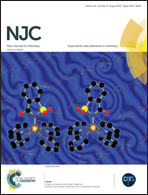New conjugated molecules with four DPP (diketopyrrolopyrrole) moieties linked by [2,2]paracyclophane as electron acceptors for organic photovoltaic cells†
Abstract
In this paper, we report two conjugated molecules 1 and 2 with four diketopyrrolopyrrole (DPP) moieties, which are linked by [2,2]paracyclophane. The energies of the highest occupied molecular orbital (HOMO) and lowest unoccupied molecular orbital (LUMO) of 1 and 2 were estimated from the respective onset oxidation and reduction potentials, which were determined on the basis of cyclic voltammetric data. Both 1 and 2 exhibit strong absorption in the visible region. Blended thin films of 1 and 2 with P3HT (poly(3-hexylthiophene)) in different weight ratios were utilized as active layers to fabricate solar cells. The results reveal that blended thin films of P3HT/1 and P3HT/2 at a weight ratio of 2 : 1 yielded the best photovoltaic performance with power conversion efficiencies (PCEs) up to 1.33% and 1.84% after thermal annealing. Blended thin films of P3HT/1 and P3HT/2 were characterized by XRD (X-ray diffraction) and AFM (atomic force microscopy) techniques. The low degree of inter-chain packing order and poor thin-film morphology are responsible for the relatively low PCEs.
![Graphical abstract: New conjugated molecules with four DPP (diketopyrrolopyrrole) moieties linked by [2,2]paracyclophane as electron acceptors for organic photovoltaic cells](/en/Image/Get?imageInfo.ImageType=GA&imageInfo.ImageIdentifier.ManuscriptID=C5NJ01118C&imageInfo.ImageIdentifier.Year=2015)

 Please wait while we load your content...
Please wait while we load your content...